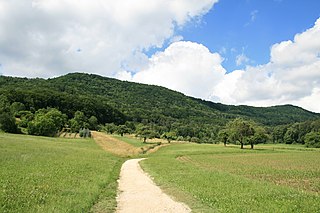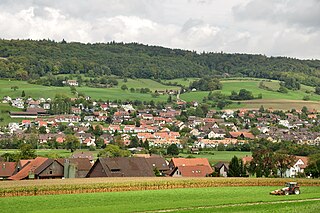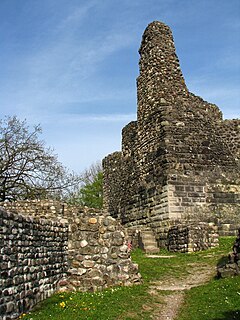
The Aletsch Glacier or Great Aletsch Glacier is the largest glacier in the Alps. It has a length of about 23 km (14 mi) (2014), has about a volume of 15.4 km3 (3.7 cu mi) (2011), and covers about 81.7 km2 (2011) in the eastern Bernese Alps in the Swiss canton of Valais. The Aletsch Glacier is composed of four smaller glaciers converging at Concordia Place, where its thickness was measured by the ETH to be still near 1 km (3,300 ft). It then continues towards the Rhône valley before giving birth to the Massa. The Aletsch Glacier is – like most glaciers on this world – a retreating glacier. As of 2016, since 1980 it lost 1.3 kilometres (0.81 mi) of its length, since 1870 3.2 kilometres (2.0 mi), and lost also more than 300 metres (980 ft) of its thickness.

The Swiss Plateau or Central Plateau is one of the three major landscapes in Switzerland, lying between the Jura Mountains and the Swiss Alps. It covers about 30% of the Swiss surface area, and is partly flat but mostly hilly. The average height is between 400 metres (0.25 mi) and 700 metres (0.43 mi) AMSL. It is by far the most densely populated region of Switzerland, the center of economy and important transportation.

Niederhasli is a municipality in the district of Dielsdorf in the canton of Zürich in Switzerland.
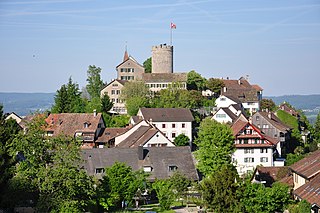
Regensberg is a municipality in the district of Dielsdorf in the canton of Zurich in Switzerland. It is located just to the west of Dielsdorf, on a ridge of the Lägern.

The Zürcher Unterland comprises the northwestern part of the canton of Zurich, including the districts of Bülach and Dielsdorf.

The Glatt Valley is a region and a river valley in the canton of Zürich in Switzerland.

Niederweningen is a terminal railway station in the Swiss canton of Zurich and municipality of Niederweningen. The station is located on the Wehntal railway line close to the border of both the municipality and the canton, and serves as the terminus of Zurich S-Bahn line S15.

Niederweningen Dorf is a railway station in the Swiss canton of Zurich and municipality of Niederweningen. The station is located close to the centre of the municipality, on the Wehntal railway line, and is served by Zurich S-Bahn line S15.

Dielsdorf is a railway station in the Swiss canton of Zurich and municipality of Dielsdorf. The station is located on the Wehntal railway line, and is served by Zurich S-Bahn line S15.

The Wehntal Railway, named after the Wehntal valley, is a standard gauge railway line running between Oberglatt and Niederweningen in Switzerland. The line in the greater Zurich area belongs to the Zurich S-Bahn network and is operated by route S15.
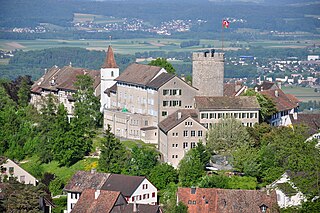
Regensberg Castle is a hill castle which was built about the mid-13th century AD by the House of Regensberg in the Swiss municipality of Regensberg in the Canton of Zürich.
Regensberg was a family of counts from the Canton of Zürich in Switzerland. The family had possessions in the medieval Zürichgau from the probably mid-11th century and became extinct in 1331 AD. With the extinction of the male line, the city republic of Zürich laid claim to the Regensberg lands and formed the Herrschaft Regensberg respectively Äussere Vogtei.

Surbtal is the name of a river valley region in the Canton of Aargau in Switzerland.
Regensberg is a municipality in the district of Dielsdorf in the canton of Zurich in Switzerland.

The Oerlikon–Bülach railway is a standard-gauge line to the north of Zürich, Switzerland. It was built by the Bülach-Regensberg-Bahn. It is also called the Gabeleisenbahn—"Y-shaped railway" in German—or the Herdöpfelbahn—"potato railway" in Swiss German—because its main freight traffic was potatoes. It was taken over by the Swiss Northeastern Railway on 1 January 1877.




